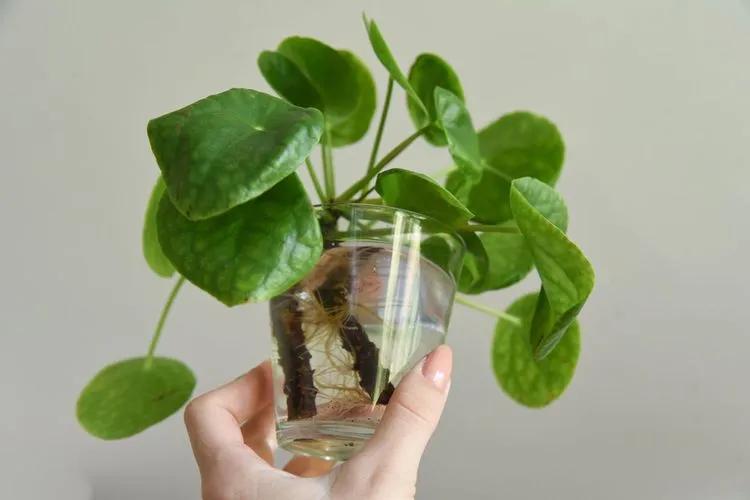Plant Water Propagation Step-By-Step Guide
Have you ever tried to propagate your plants? Probably, you had plenty of questions. Is it better to propagate in water or soil? What plants can be propagated in water? How long does it take to grow roots? How to prepare cuttings for propagation? The process seems tricky; however, water propagation is the easiest way to get new plants. You can apply it to almost any plant: stay tuned to find out how!
What Is Cutting Propagation?

Propagation is a simple way to duplicate your plant vegetatively, which means without seed sprouting, only cuttings. You put your plant’s parts in a moist medium, and they grow roots after a while. Propagation has a high success rate and enables you to grow new green pets with all the mother plant’s features like variegation, flower color, etc.
Types of Propagation
There are several ways how to propagate plants, and water propagation is the easiest one. Besides it, you may reproduce your plants by putting cuttings directly into the soil or moist sphagnum moss. The water option allows you to see if the cutting isn’t rotting and has already developed roots. Moreover, you can change water easily to prevent bacteria growth without disturbing developing roots. All these advantages make water propagation effortless.
What Plants Can Be Propagated in Water
Most indoor and some outdoor plant species can be propagated in water. The rule is simple - trees, shrubs, and herbaceous plants that grow in humid areas or reproduce vegetatively (for example, Aroids) can be propagated in a humid environment, i.e., water. Such plants as succulents can be rooted in water too.
Plants That Can Be Successfully Water Propagated

Tropical vines: Pothos, Philodendron, Monstera, Syngonium, etc.
Tropical trees and shrubs: All kinds of ficuses (Fiddle-leaf fig, Ginseng ficus, Weeping fig, and so on), Money tree, any species of Dracaena, Hybiscus, Citrus.
Indoor and outdoor herbaceous plants: Sansevieria, Croton, African violets, Peperomia, Begonia, any Tradescantia, ZZ plant, Strings of Pears, Strings of Hearts, some Geranium varieties, Mint, Basil, Tomato, Lavander, Rosemary, etc.
Some deciduous trees and shrubs: Willow, Poplar, Apple, Rose.
How to Propagate Plants in Water

Use only sterile sharp tools. If the plant is hard, use pruners or a fine saw. The neater cut you make, the more successful it will be.
Ensure the tools are clean. It is advisable to sanitize them. Imagine you are a surgeon. You don’t want to infect your plants as they are living beings too. It would be best if you washed your tools with soap or treated them with alcohol or peroxide.
Decide where you are going to prune your plants. The cutting should be of a proper length. It differs for each species. Generally, tropical and herbaceous cuttings can root with any size. There must be at least 1-2 pairs of leaves. In comparison, deciduous trees should be pretty short. The cutting must be a bit woody at the base but mostly softwood. Usually, it’s around 10 cm (4 inches) or less.
You must cut between nodes leaving some space for dieback. Nodes are places from where leaves are growing. Cut just in the middle.
Cut in 45 degrees angle. If you make a flat cut, the cutting won’t have enough surface area to absorb water.
Treat the cuts with cinnamon. It’s not obligatory, but cinnamon works as a natural fungicide and rooting hormone. Deciduous trees require rooting hormones for propagation.
Place your cutting in a water container in a place where it can get bright lighting and warm temperatures. The most suitable temperature is around 20 °C (68 °F). The lighting requirements depend on the needs of a particular species. For instance, pothos needs medium and monstera bright indirect lighting.
Change water as it seems cloudy. Usually, once a week or once in two weeks.
Plant your cuttings when you see the first roots are at least 1 cm (half an inch) long.
Common Water Propagation Problems and Their Solutions
Even easy water-propagated cuttings can run into trouble. Rotting, slow root growth, cloudy water, or wilted leaves are all pretty normal and usually have simple fixes. Here’s a quick look at the most common issues and what you can do about them.
Cuttings Are Rotting
The most common and dangerous problem is rotting. Lack of light and low temperature facilitate mold and bacteria growth. At the same time, cuttings stop developing in such conditions.
At first, it looks like the cutting is a bit dark and soft, then it turns brown or black. Rotting may occur if you don’t change the water at all. Some plants, especially trees and shrubs, require from 1 to 2 months to grow roots. If you skip all water changes, it will turn clouded and malodorous, causing rotting.
The Water Looks Green or Yellow
If your water turns green or even yellow, it’s not a problem at all. When you use a transparent container, water is constantly exposed to the sunlight, leading to algae growth. Unlike bacteria and mold, algae don’t hurt plants in any way. If you don’t want your glass of water to look green, you can scrub the algae from the walls and change the water again.
Cuttings Won’t Root
Different species root at different speeds, so you don’t need to hurry when propagating your plants. If the cutting is neither rotting nor rooting, just keep waiting. It may take a while. For example, it will take at least 3 weeks until the ZZ plant will get its first roots. Don’t change the water too much often as plants secrete phytohormones that promote rooting naturally.
The Leaves Look Wilted

A wilted look appears when the plant evaporates more water than intakes. When the plant’s turgor is low, the chances of rooting decrease. In this case, cut off some leaves. You need to prune the lower leaves to clean up the cutting part that will have roots. Then, you may cut in half the rest of the leaves or even all of them entirely. For example, lemon cuttings usually have ⅓ or ½ of each leaf, while rose cuttings may not have leaves at all to be propagated successfully.
FAQ
How to Care for Plants During Water Propagation?
Plants rooting in water don’t need much – just clean water, good light, and a bit of patience. Keep the container out of direct sunlight, change the water when it looks cloudy, and make sure the node stays underwater.
Water propagation is easy and fascinating. We hope this information was helpful and it aroused your wish to multiply your green friends. Use the tips both in your garden and at home. Remember that plants make the world better, so do something green today!
